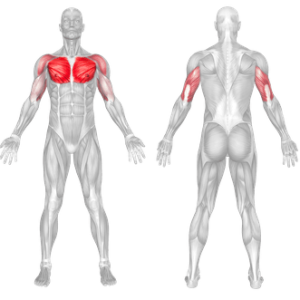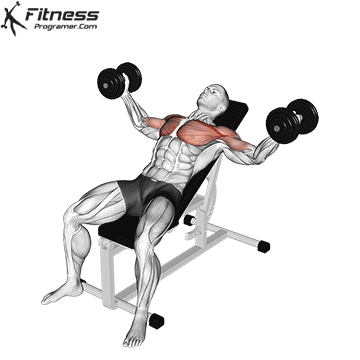Incline Dumbbell Fly Overview
The Incline Dumbbell Fly is a weight-training exercise targeting the pectoralis major (chest muscles), particularly the upper portion. It also engages the anterior deltoids (front shoulders) and stabilizing muscles in the arms and core. This exercise is performed on an incline bench using a pair of dumbbells.
How to:
Setup
- Adjust a bench to an incline angle, typically 30–45 degrees.
- Sit on the bench and position your feet flat on the ground for stability.
- Hold a dumbbell in each hand with a neutral grip (palms facing each other).
- Lie back on the bench with the dumbbells held above your chest, arms extended but elbows slightly bent.
Execution
- Inhale as you slowly lower the dumbbells in a wide arc, keeping your elbows slightly bent to protect your joints.
- Lower until your upper arms are roughly parallel to the floor, or you feel a comfortable stretch in your chest.
- Exhale as you bring the dumbbells back to the starting position, following the same arc.
Tips for Proper Form
- Avoid locking out your elbows to keep tension on the chest.
- Keep your movements controlled—don’t let the dumbbells drop too fast.
- Avoid over-stretching, as it could strain your shoulders.
- Maintain a natural arch in your lower back but avoid overarching.
Common Mistakes
- Overloading: Using weights that are too heavy can compromise form and increase injury risk.
- Incorrect Bench Angle: An incline that’s too steep shifts emphasis to the shoulders rather than the chest.
- Locking Elbows: Reduces chest engagement and increases stress on the joints.
- Rushed Reps: Using momentum instead of controlled motion reduces effectiveness.
Benefits Of Incline Dumbbell Fly
1. Targets the Upper Chest
- The incline position shifts the emphasis to the clavicular head of the pectoralis major (upper chest), helping to build strength and muscle definition
- Developing the upper chest improves overall chest symmetry and contributes to a fuller, more balanced chest appearance
- Upper chest strength is particularly important for athletic performance, as it aids in pushing movements, such as those used in sports like basketball or swimming.
2. Improves Range of Motion
- The wide arc of the fly emphasizes a stretch in the chest muscles, which can improve flexibility
- This enhanced range of motion can translate to better performance in other exercises, such as the bench press, as well as improved mobility
- The stretch also encourages muscle elongation, which can reduce tightness in the chest caused by prolonged sitting or poor posture.
3. Enhances Chest Aesthetics
- By isolating the chest muscles and focusing on controlled motion, the Incline Dumbbell Fly contributes to muscle hypertrophy
- Including this exercise alongside flat bench and decline flys helps target the chest from different angles
- For bodybuilders and fitness enthusiasts, this exercise is valuable for shaping the upper chest, creating a lifted, sculpted appearance.
4. Stabilizer Activation
- The unilateral (independent arm movement) nature of the exercise challenges the stabilizing muscles in your chest, shoulders, and arms, such as the rotator cuff and serratus anterior.
- This improved stabilization reduces the risk of injury in compound movements like the bench press or push-ups, where maintaining control is crucial.
- Engaging stabilizers can also enhance core strength, as the body works to maintain balance on the incline bench during the exercise.
- Over time, this can lead to improved shoulder joint integrity, reducing the likelihood of shoulder injuries and improving overall functionality.
Muscles worked


